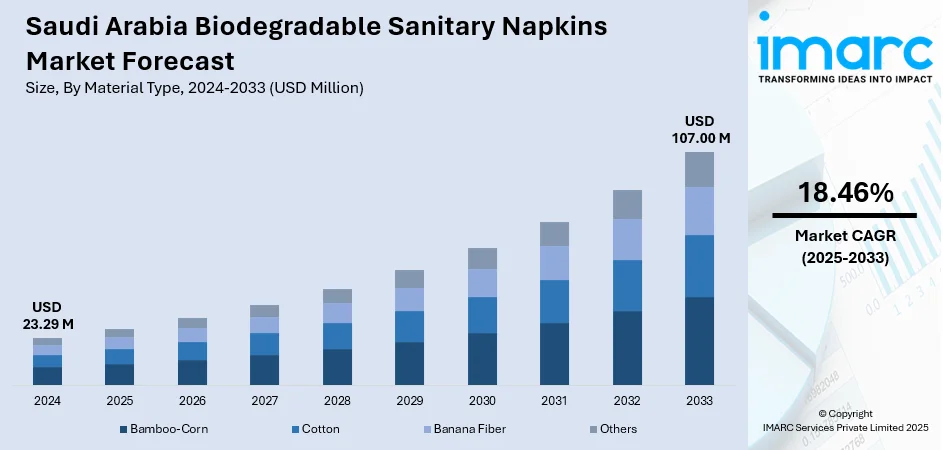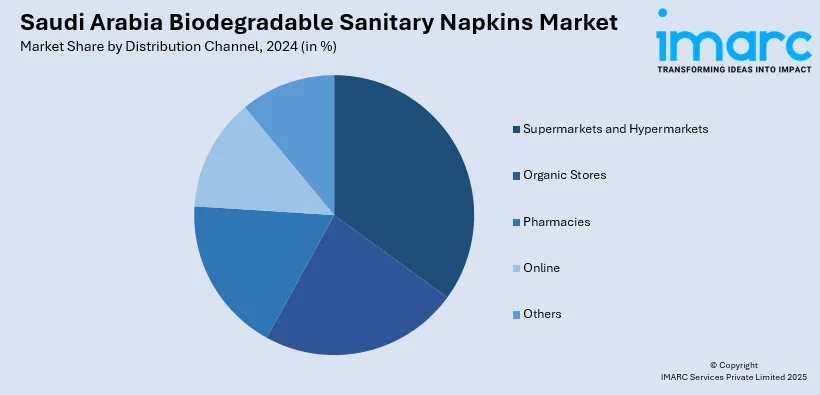
Saudi Arabia Biodegradable Sanitary Napkins Market Size, Share, Trends and Forecast by Material Type, Distribution Channel, and Region, 2025-2033
Saudi Arabia Biodegradable Sanitary Napkins Market Overview:
The Saudi Arabia biodegradable sanitary napkins market size reached USD 23.29 Million in 2024. Looking forward, IMARC Group expects the market to reach USD 107.00 Million by 2033, exhibiting a growth rate (CAGR) of 18.46% during 2025-2033. The market is driven by rising environmental awareness, expanding demand for chemical-free and sustainable products, and expanding health consciousness among women. Government support for promoting eco-friendly products and a cultural transition toward individual wellness and hygiene are also increasingly driving the uptake of biodegradable menstrual products.
|
Report Attribute
|
Key Statistics
|
|---|---|
|
Base Year
|
2024
|
|
Forecast Years
|
2025-2033
|
|
Historical Years
|
2019-2024
|
| Market Size in 2024 | USD 23.29 Million |
| Market Forecast in 2033 | USD 107.00 Million |
| Market Growth Rate 2025-2033 | 18.46% |
Saudi Arabia Biodegradable Sanitary Napkins Market Trends:
Movement Toward Sustainable Materials
There is a growing shift toward the application of sustainable materials influencing the Saudi Arabia biodegradable sanitary napkins market outlook. Natural fibers like organic cotton, bamboo, and cornstarch are being widely used by manufacturers, as these are biodegradable and get decomposed much faster compared to conventional synthetic products. The reason behind this change is the rising awareness about the environment and an effort to limit plastic waste. People are becoming increasingly aware of the environmental footprint of their purchases, resulting in a desire for products that are aligned with sustainable principles. The utilization of such materials helps address environmental issues and also meets the increasing demand for hypoallergenic and chemical-free products, boosting consumer confidence and satisfaction. Consequently, brands are getting creative to include these materials in their products, making the market more sustainable and health-focused.

Increase in Health-Conscious Consumer Trends
Health-consciousness among women is increasingly contributing to the Saudi Arabia biodegradable sanitary napkins market share. Women are becoming more selective about the products they use,and are looking for products that are free from synthetic chemicals, fragrances, and dyes. Biodegradable sanitary napkins, which are typically constructed of natural materials, are seen as safer and friendlier on the skin, minimizing the risk of irritation and allergy. This is also fueled by increasing concern over the possible health hazards of traditional products, for example, coming into contact with carcinogenic chemicals. Consequently, consumers are turning toward products that are good both for individual health and the environment. Moreover, manufacturers are meeting this demand by creating products that conform to health specifications and also to environmental principles, thus serving the changing needs of customers who prioritize health.
Emerging Distribution Channels
As distribution channels for biodegradable sanitary napkins in Saudi Arabia develop, some products are becoming increasingly accessible to a broader population. Conventional retail stores such as supermarkets and pharmacies are now stocking environmentally friendly products, owing to consumer demand. Moreover, it is now easier for online channels to provide easy access to these products for customers living in remote locations, while providing convenience and variety at the same time. Online platforms also offer elaborate information about products, which helps with informed buying decisions. The broadening of distribution channels is also beneficial in promoting availability and visibility of biodegradable sanitary napkins for consumers who regard sustainability and health as priority considerations. Wider access fuels the Saudi Arabia biodegradable sanitary napkins market growth, thus mirroring a larger change toward environment-friendly consumerism in Saudi Arabia.
Saudi Arabia Biodegradable Sanitary Napkins Market Segmentation:
IMARC Group provides an analysis of the key trends in each segment of the market, along with forecasts at the regional level for 2025-2033. Our report has categorized the market based on material type, and distribution channel.
Material Type Insights:
- Bamboo-Corn
- Cotton
- Banana Fiber
- Others
The report has provided a detailed breakup and analysis of the market based on the material type. This includes bamboo-corn, cotton, banana fiber, and others.
Distribution Channel Insights:

- Supermarkets and Hypermarkets
- Organic Stores
- Pharmacies
- Online
- Others
A detailed breakup and analysis of the market based on the distribution channel has also been provided in the report. This includes supermarkets and hypermarkets, organic stores, pharmacies, online, and others.
Regional Insights:
- Northern and Central Region
- Western Region
- Eastern Region
- Southern Region
The report has also provided a comprehensive analysis of all the major regional markets, which include Northern and Central Region, Western Region, Eastern Region, and Southern Region.
Competitive Landscape:
The market research report has also provided a comprehensive analysis of the competitive landscape. Competitive analysis such as market structure, key player positioning, top winning strategies, competitive dashboard, and company evaluation quadrant has been covered in the report. Also, detailed profiles of all major companies have been provided.
Saudi Arabia Biodegradable Sanitary Napkins Market News:
- In July 2023, Saudi siblings Nora and Joud Alorainy introduce the Kingdom’s first line of biodegradable feminine hygiene products, branded as 'C.' The firm offers organic and biodegradable menstrual pads that are "thoughtfully crafted" for women, by women. The sustainability-focused brand raises awareness about the significance of using biodegradable menstrual pads through its products and mission. Moreover, according to clinical trials conducted by the Saudi company on its products, organic pads and feminine products have demonstrated greater absorbency.
Saudi Arabia Biodegradable Sanitary Napkins Market Report Coverage:
| Report Features | Details |
|---|---|
| Base Year of the Analysis | 2024 |
| Historical Period | 2019-2024 |
| Forecast Period | 2025-2033 |
| Units | Million USD |
| Scope of the Report | Exploration of Historical Trends and Market Outlook, Industry Catalysts and Challenges, Segment-Wise Historical and Future Market Assessment:
|
| Material Types Covered | Bamboo-Corn, Cotton, Banana Fiber, Others |
| Distribution Channels Covered | Supermarkets and Hypermarkets, Organic Stores, Pharmacies, Online, Others |
| Regions Covered | Northern and Central Region, Western Region, Eastern Region, Southern Region |
| Customization Scope | 10% Free Customization |
| Post-Sale Analyst Support | 10-12 Weeks |
| Delivery Format | PDF and Excel through Email (We can also provide the editable version of the report in PPT/Word format on special request) |
Key Questions Answered in This Report:
- How has the Saudi Arabia biodegradable sanitary napkins market performed so far and how will it perform in the coming years?
- What is the breakup of the Saudi Arabia biodegradable sanitary napkins market on the basis of material type?
- What is the breakup of the Saudi Arabia biodegradable sanitary napkins market on the basis of distribution channel?
- What is the breakup of the Saudi Arabia biodegradable sanitary napkins market on the basis of region?
- What are the various stages in the value chain of the Saudi Arabia biodegradable sanitary napkins market?
- What are the key driving factors and challenges in the Saudi Arabia biodegradable sanitary napkins market?
- What is the structure of the Saudi Arabia biodegradable sanitary napkins market and who are the key players?
- What is the degree of competition in the Saudi Arabia biodegradable sanitary napkins market?
Key Benefits for Stakeholders:
- IMARC’s industry report offers a comprehensive quantitative analysis of various market segments, historical and current market trends, market forecasts, and dynamics of the Saudi Arabia biodegradable sanitary napkins market from 2019-2033.
- The research report provides the latest information on the market drivers, challenges, and opportunities in the Saudi Arabia biodegradable sanitary napkins market.
- Porter's five forces analysis assist stakeholders in assessing the impact of new entrants, competitive rivalry, supplier power, buyer power, and the threat of substitution. It helps stakeholders to analyze the level of competition within the Saudi Arabia biodegradable sanitary napkins industry and its attractiveness.
- Competitive landscape allows stakeholders to understand their competitive environment and provides an insight into the current positions of key players in the market.
Need more help?
- Speak to our experienced analysts for insights on the current market scenarios.
- Include additional segments and countries to customize the report as per your requirement.
- Gain an unparalleled competitive advantage in your domain by understanding how to utilize the report and positively impacting your operations and revenue.
- For further assistance, please connect with our analysts.
 Request Customization
Request Customization
 Speak to an Analyst
Speak to an Analyst
 Request Brochure
Request Brochure
 Inquire Before Buying
Inquire Before Buying




.webp)




.webp)












